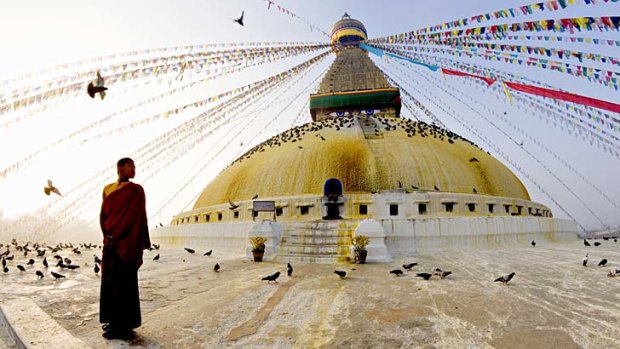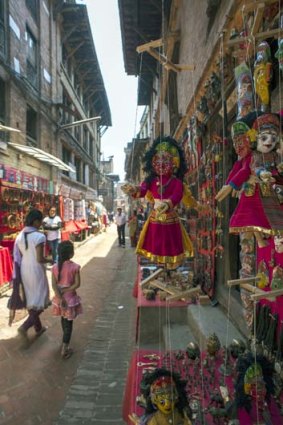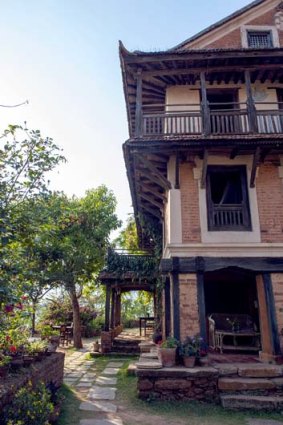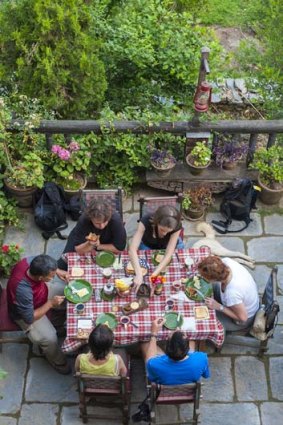
New Nepal... Boudhanath stupa in Kathmandu.Credit: Getty Images
Leisa Tyler discovers the Himalayan nation is gearing up for a new generation of well-heeled travellers.
In the 1960s, Nepal's capital, Kathmandu, was best known as the last stop on the hippie trail, an overland route linking Europe to Asia that was famed for the dreadlocked, free-loving social deviants it attracted and the pot-growing countries it passed through.
Of course, the hippies - and countless backpackers that followed - didn't come to Nepal just for its beatnik vibe and woopy-weed, which grows wild and had been used by ancient Hindu sadhus for thousands of years. Their tales recounted a kingdom bestowed with extraordinary landscapes: undulating hills terraced with crops of corn, rice and wheat; wild rivers; plunging gorges and forested valleys framed by the awe-inspiring Himalayas (Nepal has eight of the 10 highest mountains in the world). And they swapped stories of the laid-back and devout Nepalese and their remarkable wooden temples and stone monuments.

Shopping in Bhaktapur.Credit: Leisa Tyler
Then, in 1996, the Maoists - considered terrorists by many Western governments - mounted a rebellion to oppose the country's feudal rule. The massacre of nine members of the royal family in 2001 by an enraged prince didn't help matters and was a likely catalyst for the monarch's downfall; the king was ousted from power by the Maoists in 2006.
More than 15,000 people died in Nepal's civil war. Frequent clashes between the Maoist insurgents and the monarch-backed army made travel to many areas outside the capital dangerous. Tourism, a major contributor to the country's income, slowed to a trickle and Nepal's ailing economy slumped even further.
Economic conditions have improved marginally since 2006, but Nepal is still ranked one of the poorest countries in the world. And, in late May, after four years and as many deadlines, the factious Maoist majority parliament failed to agree on, and write, a constitution, generating more political uncertainty and instability.

The Famous Farm, Nuwakot.Credit: Leisa Tyler
Unemployment is high and rural poverty is rife. Last year, 400,000 Nepalese men took labouring and security jobs in Malaysia and the Gulf countries.
During my stay in Kathmandu at the end of April, there was a fuel shortage. Some service stations have closed; others have queues of cars and motorbikes stretching up to three kilometres. Investment in electricity plants dried up during the civil war and the country now has chronic power shortages. In winter, when the river sources freeze and the hydroelectric plants slow, it's not unheard of to have only four hours of electricity a day. Last winter, Kathmandu ran out of gas and kerosene as well.
"My house is a SAR," a restaurateur, Anudan Rana, tells me. "A self-autonomous region. When the electricity fails, I have batteries. When those run out, we switch to a generator. When we run out of fuel [for the generator], we have solar.

Breakfast at the Old Inn Bandipur.Credit: Leisa Tyler
"In Nepal, you have to have a back-up for the back-up."
Hoping to reignite the economy, the Nepalese government is looking to its old cash cow: tourism. The government declared last year to be "Visit Nepal Year", and people did. Drawn to the same landscapes and cultural sites that fascinated travellers on the hippie trail, last year's arrivals were up 21 per cent compared with 2010.
"Nepal is safe and open for business," a manager at the Nepal Tourism Board, Diwaka Rana, says. "Now that tourists are coming back, we want to change our reputation as a cheap destination," he says of the government's desire to attract a more discerning, well-heeled clientele than the backpackers and flashpackers who currently visit.
It might be putting the cart before the horse. Nepal has some delightful places to stay but no international-standard luxury hotels. The roads are generally in appalling condition and it takes hours to get anywhere, especially in Kathmandu. The city's rivers are highly polluted and immigration queues at the international airport are long and disorderly. Passengers on my flight from Delhi wait 90 minutes for visas to be processed. Visas can be paid for in almost any currency, except Indian or Nepalese rupees. Some visitors are forced to withdraw Nepalese rupees from an ATM, then exchange them - at an unfavourable rate - into another currency. I pay my visa with a €50 ($62) note. The immigration officer smugly says "Sorry! No change!" when I request the €20 difference.
However, changes in the private sector are more heartening. A clutch of new restaurants and hotels have opened recently in Kathmandu, including Rana's stylish diner, Grill Me, serving superb dishes such as fried local goat's cheese and hot chocolate fondant with mascarpone cream. It's one of 40 to have opened in the Jhamsikhel neighbourhood in the past year.
The quiet Tibet International hotel, which opened in November, is a 68-room property overlooking Kathmandu's Buddhist stupa and World Heritage site, Boudhanath. It has wooden floors, carved Buddhist motifs and brocade hangings.
In Patan - one of the three ancient cities in the Kathmandu Valley - Swotha is a 70-year-old family residence that opened as a seven-room hotel in January. The minimalist rooms have concrete floors, king-size beds dressed in soft raw cotton, balconies and compact en suites. A breezy rooftop courtyard and ground-floor tapas bar complete the picture. Swotha is the debut project of Traditional Homes, a group of hospitality professionals who are transforming old family mansions - many on the verge of collapse - into hotels, while keeping ownership with the family.
Nepal's standard-setting jungle lodge, Tiger Tops, recently reopened Karnali Lodge on the edge of Bardia National Park in southern Nepal. The lodge's 20 wood and rammed-earth rooms have been built with minimal impact on the environment and are powered by solar energy.
Dwarika's, an indigenous Newari-style hotel in Kathmandu that is often cited as the city's best, is putting the finishing touches on a boutique property in the hills of Dhulikhel, a 90-minute drive from the capital. Dwarika's Himalayan Shangri-La has 36 simple but comfortable rooms, with wooden floors and local textiles in Newari cottages. The downside is climbing 300-odd stairs to get there - and another 150 stairs down to the restaurant; the upside is the views, stretching over the snow-capped peaks of the Langtang Mountains and Kavrepalanchok valley below.
Trekking outfitter Himalayan Encounters has opened a rural retreat overlooking the 18th-century World Heritage-listed Nuwakot Palace, a three-hour drive from Kathmandu. Called the Famous Farm, this lovely old rammed-earth and wood mansion has six rustic rooms, with another two in an annex above the kitchen. It's a superb place to relax, though the quality is low for the price: the beds are hard, the sheets are pilled and ripped and the staff appear as though they would rather be climbing mountains.
Himalayan Encounters' second property, the Old Inn Bandipur, excels in service. With a chirpy group of friendly staff, this rabbit-warren heritage lodge, which is popular with flashpackers, has clay-tile floors, Newari antiques and plenty of charm.
Midway between Kathmandu and the city of Pokhara, the stone one-street village of Bandipur grew wealthy as a trading hub in the 19th century for Tibetan tea, brocade and salt going to India, and for Indian silk, gemstones and rice to Tibet. Lined with splendid French and Italian-influenced mansions - popular with wealthy merchants of the day - Bandipur was almost a ghost town before being rediscovered by tour operators a few years ago. Thanks to small local companies, such as Himalayan Encounters, it's undergoing a facelift; old mansions are being converted into small hotels and restaurants, reinvigorating the economy and providing employment.
Also on a grassroots level, the Netherlands aid agency SNV, with the Nepal government, recently finished mapping the Nepal section of the Great Himalaya Trail, a walking trail that will eventually stretch the breadth of the Himalayan mountains, covering 8000 kilometres and five countries.
For now, the trail's focus is alleviating rural poverty through tourism. Most of Nepal's 750,000 annual tourists come to trek in the Himalayas; more than 85 per cent of these stick to the three best-known trails: Annapurna, Everest and Langtang.
By mapping little-known trails in off-beat destinations, it's hoped the Great Himalaya Trail will encourage travellers to explore new regions, creating jobs and income for communities along the way. Routes along the trail span all levels of skill and difficulty and have been tried, tested and categorised.
"We want to get tourists to explore beyond the established trekking areas," an SNV tourism adviser, Paul Stevens, says. "We hope to make an asset out of Nepal's rugged landscapes and remote and often-inaccessible mountain regions - elements that often hinder economic development."
FAST FACTS
Getting there
Singapore Airlines has a fare to Kathmandu from Sydney and Melbourne for about $1190 low-season return, including tax. Fly to Singapore (about 8hr), then with SilkAir to Kathmandu (5hr 10min); see singaporeair.com. This fare allows you to fly back from another subcontinent city (taxes will vary). Australians require a visa for a stay of up to 30 days.
Staying there
Kathmandu's Tibet International has double rooms from $US92 ($92); see hoteltibetintl.com.np.
Swotha has seven double rooms in Kathmandu's Patan neighbourhood from $US80 a night, including breakfast; see traditionalhomes.com.np.
The Famous Farm and Old Inn Bandipur have double rooms from $US98, including all meals and guided day walks; rooms with attached bathroom cost more; see himalayanencounters.com.
Karnali, a lodge near Bardia National Park in southern Nepal, has rooms from $US307 a person, twin share, including full board and all resort-based activities; see tigertops.com.
The Dwarika's Himalayan Shangri-La, near Dhulikhel, a 90-minute drive from Kathmandu, has double rooms from $US192, including breakfast; see dwarikashimalayanshangrila.com.
More information
The Great Himalaya Trail is a free portal offering trekking information and maps; see www.thegreathimalayatrail.org.
Sign up for the Traveller Deals newsletter
Get exclusive travel deals delivered straight to your inbox. Sign up now.